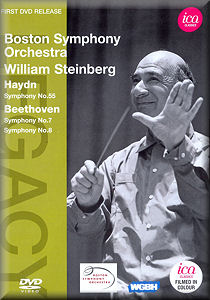 |
 |
|


alternatively
MDT
AmazonUK
AmazonUS
|
Joseph HAYDN
(1732-1809)
Symphony no.55 in E flat Hob.I/55 [21:54]
Ludwig van BEETHOVEN (1770-1827)
Symphony no.7 in A op.92 [37:55]
Symphony no.8 in F op.93 [26:07]
 Boston Symphony Orchestra/William Steinberg
Boston Symphony Orchestra/William Steinberg
rec. 7 October 1969 (Haydn), 6 October 1970 (sy 7), 9 January 1962
(sy 8), Symphony Hall, Boston (Haydn, sy 7), Sanders Theatre, Harvard
University (sy 8)
 ICA CLASSICS
ICA CLASSICS  ICAD 5067 [86:00]
ICAD 5067 [86:00]
|
|
|
For most record collectors the name of William Steinberg is
synonymous with the Pittsburgh Symphony Orchestra, of which
he was musical director from 1952 to 1976 and with which he
made a long series of well-considered recordings. Londoners
scarcely recall that he was Boult’s successor as principal conductor
of the London Philharmonic Orchestra in 1958. Ill-health ended
what may have been a promising association in 1960.
Illness also prevented his conductorship of the Boston Symphony
Orchestra (1968-1972) from becoming more than a hiatus. As Richard
Dyer’s notes – a welcome recurring feature of this series –
tell us, the period in question was more notable for the opportunities
his cancellations offered to his young assistant Michael Tilson
Thomas.
Steinberg’s appointment to Boston came at a time of low morale
for the orchestra. Leinsdorf’s period had not worked out, for
reasons not readily explained by the video material emerging
in this series. Great things had been expected of Steinberg,
who had been assistant to both Klemperer and Toscanini and was
famed as an orchestra builder. It is therefore interesting to
have at least one early colour video of him in action with the
orchestra during his tenure, plus a guest appearance from somewhat
earlier, filmed in black and white. What it doesn’t explain
is why anyone should have thought he could do anything Leinsdorf
couldn’t. Both, after all, were eminently straightforward interpreters
with a strong eye for orchestral discipline. Nearly fifty years
on it is Leinsdorf who seems to have had the more enquiring
mind and – at least often enough for it to be worth keeping
him on – the ability to create a sense of occasion. Possibly
the contrast between Leinsdorf’s acerbic wit and what Dyer describes
as Steinberg’s “pipe-smoking geniality” carried more weight
with good Bostonian society that the actual performances.
Steinberg’s movements were famously minimalist. However, like
many conductors of an earlier generation, he used a longish
baton and presumably expected the players to follow the tip
of it, rather than his arm movements. Looked at this way his
stick is actually both energetic and vital. I was curious to
note that, when beating three-time, his second beat goes to
his left, rather than to the right as is more usual. This can
be seen very clearly at the beginning of the Haydn. No doubts
about his clarity, however.
Steinberg’s four performances of Haydn’s Symphony no.55 in 1969
are apparently the only ones the orchestra has given of this
work. Unlike Munch conducting no.98 in 1960, Steinberg has a
harpsichord, particularly active in the slow movement. This
sounds big-band Haydn today but is slimmed-down by the light
of its times. It’s all very neat, buoyant and nicely phrased.
The Beethoven symphonies are resolved with swift tempi, clean
textures and clear phrasing. The effect is again buoyant rather
than driven. Many conductors who take the first movement of
no.7 swiftly are unable to maintain proper articulation of the
dotted rhythms right through. The beginning of the development
is a danger point where even Reiner falters. Steinberg is one
of the best I’ve heard from this point of view.
But, having admired the performances for their avoidance of
pitfalls, I still can’t help feeling that the Boston Symphony
Orchestra under its music director ought to have offered something
more. There was a greater distinction in the public view back
then between the “big five” American orchestras and all the
others, good as many of them were. Pittsburghers had every reason
to be proud of having such a tip-top bandmaster for over two
decades. Impecunious record collectors in the UK who got to
know Beethoven symphonies through Steinberg’s Pittsburgh recording
as issued on Music for Pleasure had cause for gratitude that
they could obtain such an excellent introduction so cheaply.
I am sure that Steinberg’s guest appearances with the “big five”
were justly appreciated. But did he have that something extra
you expect from the music director of one of the “big five”?
Go to Leinsdorf’s performance of the “Egmont” overture in this
same series, right at the end of his criticized reign and you’ll
hear that something extra – a Beethoven orchestra in full cry
and a conductor inspiring them, not just directing them.
I’m sure purchasers will enjoy this video, but the real revelations
of this series so far have been the Leinsdorf issues, though
I say that without having heard all the Munch ones, which are
pretty numerous.
Useful documentation of a conductor whose time with the orchestra
was short.
Christopher Howell
|
|

